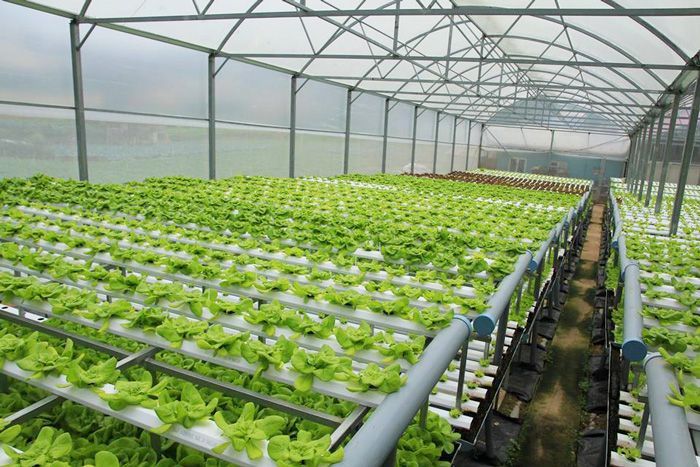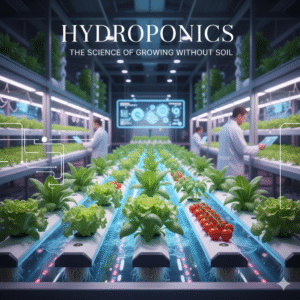
Kavindya Senevirathna

Hydroponics is a modern scientific method of growing plants and vegetables without soil, using a special nutrient solution in water. In traditional cultivation, the soil provides nutrition to plants, depending heavily on land, water, weather, and environment. However, hydroponics has transformed this system into a science that supplies nutrients directly through water. Here, plants grow in a specially designed water system, and their nutrients are precisely controlled in specific ratios.
The basic idea of hydroponics is to provide plants with the essential elements needed for growth, water, oxygen, and nutrients in perfect balance. What makes it remarkable is that plants are nourished safely in an artificial environment, without relying on the nutrients found in soil. Once a subject of scientific research, hydroponics has now become a global revolution in cultivation.
In traditional farming, many factors depend on the soil’s properties. Soil instability, toxins, diseases, weather changes, and water shortages often affect cultivation, resulting in reduced yields or damaged crops. Hydroponics provides an effective solution to these problems by creating a controlled system where plant nutrition depends on science, not soil or weather.
The water used in hydroponic systems is a scientifically prepared nutrient solution containing nitrogen, potassium, magnesium, calcium, and trace minerals essential for plant growth. This is not ordinary water; it is carefully regulated for temperature and pH values. Plants absorb these nutrients directly through their roots, ensuring they receive balanced nourishment.
Since hydroponics uses no soil, plant roots are not buried but remain suspended in the nutrient solution. This allows more oxygen to reach the roots, promoting faster growth. Studies show that hydroponic plants can grow 30%–50% faster than those in traditional cultivation, and when nutrients are properly balanced, their quality and taste improve significantly.
Hydroponics also requires very little space. Vegetables and fruits can be grown even in urban areas without harming the environment. Many countries now use hydroponic systems within city limits to produce essential food, minimizing land use and contributing greatly to future food security.
There are several main types of hydroponic systems: Nutrient Film Technique (NFT), Deep Water Culture (DWC), Ebb and Flow, Drip System, and Aeroponics. Although their principles are similar, their operations differ. In NFT, a thin film of nutrient solution continuously flows past plant roots. In DWC, roots are directly immersed in water. In Aeroponics, roots are nourished by a fine nutrient mist in the air. These systems can be chosen according to commercial or household needs.
Hydroponics offers numerous advantages. Since there is no soil, there are no soil-related problems. Because it is independent of climate and weather, cultivation can continue throughout the year. Water is recycled, reducing consumption by up to 80% compared to traditional farming. Pests and diseases are minimized, and controlled nutrition enhances both plant health and yield.
However, hydroponics also presents challenges. It requires scientific precision; nutrient balance, pH value, and water temperature must be correctly maintained. Any imbalance can harm the plants. Initial setup costs can be high due to the need for equipment and materials, but over time, the system becomes cost-effective.
The hydroponic process depends on scientific control. Nutrient compounds are measured accurately, and the pH level is usually kept between 5.5 and 6.5. Water temperature is ideally maintained between 18°C and 24°C for healthy growth. Modern hydroponic systems often use automated or digital control equipment to ensure accurate management.
Selecting the right plants is also crucial. Hydroponics is not suitable for all species; crops must be chosen based on their nutritional needs and growth rate. Lettuce, cucumbers, peppers, basil, eggplants, tomatoes, and strawberries adapt especially well to hydroponic systems because of their small root structures and fast growth cycles.
This method also allows easy control over a plant’s life cycle. Growers can regulate nutrition and harvest timing precisely. Many commercial farms use indoor hydroponic systems with artificial lighting, enabling vegetable production in warehouses or high-rise buildings without sunlight. This innovation has led to the rise of Vertical Farming.
Vertical farming applies hydroponic principles to large-scale, layered systems. Nutrient solutions are automatically distributed to plants grown in multiple tiers, maximizing space efficiency. Large urban warehouses with multiple floors can now function as farms, making this a promising technology to help solve future food shortages.
Technology plays a vital role in modern hydroponics. Many systems are now controlled by IoT (Internet of Things) devices. Parameters such as pH, temperature, nutrient content, and light intensity are automatically monitored and adjusted through electronic controllers, creating what is known as “Smart Hydroponics.”
With the global population increasing and arable land decreasing, the agriculture of the future will rely heavily on hydroponics. Scientists estimate that by 2050, when the population nears nine billion, traditional farming will struggle to meet food demands. Hydroponics, which conserves space and water while offering continuous production, could play a key role in addressing global food insecurity.
This method also benefits the environment. Much of the world’s farmland has been degraded, and soil toxicity poses serious ecological challenges. Hydroponics minimizes such damage by allowing plants to grow cleanly in controlled environments. It reduces chemical runoff, protecting soil and water resources.
Hydroponic systems recycle water, drastically reducing waste. Scientific studies show that hydroponics uses 80–90% less water than traditional farming, making it ideal for arid regions and countries facing water scarcity.
Economically, hydroponics offers long-term profitability. Proper nutrient control increases yield and reduces loss. Savings from lower water use, minimal soil preparation, and reduced land requirements make hydroponic cultivation a sustainable business model. It ensures stable production and income for growers.
Around the world, hydroponic methods continue to evolve. “Greenhouse Hydroponics” combines this technology with climate control, regulating heat, light, and humidity to create ideal growing conditions year-round. Plants are protected from weather extremes and can maintain steady growth.
Recent research has also introduced Bioponics, a hybrid system combining hydroponics and organic cultivation. Instead of synthetic compounds, nutrients are derived from natural materials, making it a more environmentally friendly approach.
New technologies such as data analysis, AI, and robotics are now part of hydroponic farming. Robots can automatically distribute water and nutrients, reduce human labor and improve efficiency.
Hydroponics has reshaped how humanity understands cultivation and survival. As resources on Earth become limited, hydroponics offers a sustainable path forward. It demonstrates that plants — and perhaps humans — can thrive when their environment is carefully balanced. Scientists have proven that life can sustain itself without soil, solely through the right mixture of water and nutrients, marking a revolutionary step in agriculture and ecology.
Ultimately, hydroponics is more than a method of growing plants in water. It teaches humanity a vital lesson — that life depends on the environment, but with knowledge and balance, we can create new possibilities. When nutrition exists in water, life is not confined to the soil. Thus, hydroponics is not only a scientific innovation but also a vision of harmony between intelligence, nature, and the future of human life.